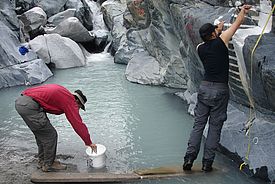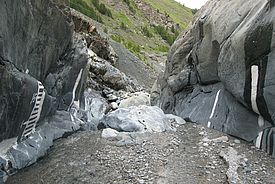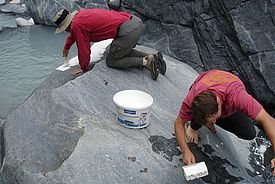23.12.2016 | News
Painting not for art but for science: Researchers of the Swiss Federal Institute for Forest, Snow and Landscape Research WSL and German colleagues have painted the walls of a gorge near Zermatt in Switzerland. They are testing a low-cost method to measure be
Especially in rough terrain installing devices that continuously measure erosion of bedrock river beds by sediments is tricky. In a new feasibility study, scientists of the WSL and the Helmholtz Centre Potsdam - GFZ German Research Centre for Geosciences show how erosive processes can be visualized by simple painting.
Understanding erosion processes
In the Gornera gorge near Zermatt, the scientists applied horizontal and vertical patterns of paint on an area of thirty times five meters of rock. They monitored them for three years via photographs taken from defined positions. Based on these pictures they were able to show the erosive processes over time that become visible by the removal of the paint.
They call the new method “erosion painting”. Erosion painting allows for analysis of the spatial distribution and intensity of erosive processes in a riverbed. Knowledge on this helps to better understand the physics behind erosion. The study aims at implementing the new method within process research.
Cheap and simple
Until now, sophisticated techniques like photogrammetry, fixed monitoring stations, laser scanning, or erosion sensors had to be applied to measure and map topographic changes on rock surfaces. But “why so complicated?” the scientists asked themselves.
Erosion painting needs no expensive installation, can be applied fast and on high-resolution even in rough terrain, and only requires visual inspection via photography. „Using paint is a cheap and simple method to analyze the spatial distribution of erosive processes. With this study we would like to show that this method can be applied for science“, explains Jens Turowski of the GFZ.
Validated by laser scanning
By repeated laser scans the scientists validated their method. This also revealed that laser scanning cannot assess erosion rates on smallest sub-millimeter scale, which erosion painting makes visible.
The scientists only used environmental friendly, water-insoluble latex paint. To minimize the effect on nature the scientists advise to use the paint sparsely and to avoid using it in sensitive areas.
Copyright
Copyright
WSL and SLF provide the artwork for imaging of press articles relating to this media release for free. Transferring and saving the images in image databases and saving of images by third parties is not allowed.
Links and documents
- Source: Helmholtz Centre Potsdam - GFZ German Research Centre for Geosciences
- Alexander R. Beer, James W. Kirchner, Jens M., Turowski, 2016. Graffiti for science – Erosion painting reveals spatially variable erosivity of sediment-laden flows. Earth Surface Dynamics 4, 885-894. DOI: 10.5194/esurf-4-885-2016



